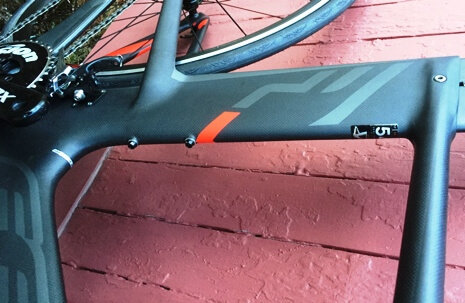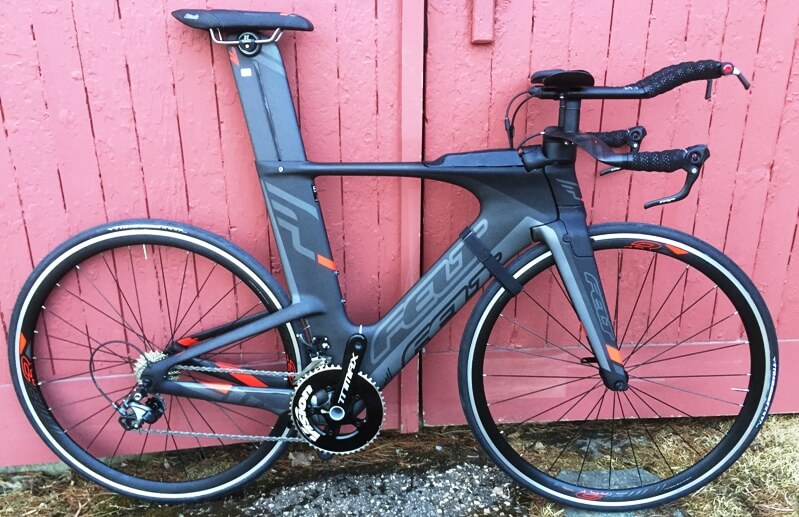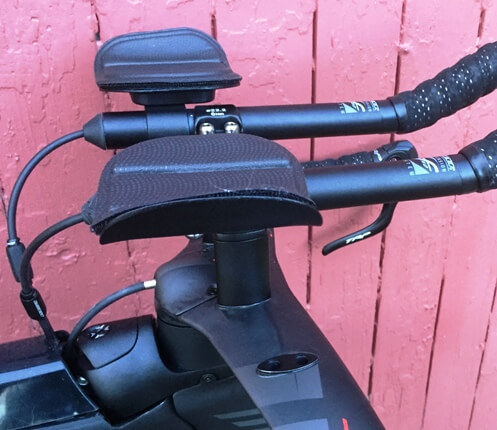An Overview of the Felt IA and a Review of the Felt IA4
By Jim Weaver, Service Manager
Fit Werx, VT
I’ll get this out of the way early, the ’15 Felt IA4 looks BAD and I mean this in the best possible way. The Felt IA looks like a cross between a tri bike and a fighter jet or like the bike Darth Vader might ride. However you want to try to categorize it, this bike looks more than a little menacing. The question is whether or not it backs up those looks with commensurate performance…
The IA line of bikes is Felt’s newest entry into the non-UCI legal “superbike” market. Don’t try showing up with one of these at your next UCI time trial. After the commissars have fallen down laughing they will kick you out of the race. Very little ab out the Felt IA meets the UCI’s aspect ratio requirements. Basically, the aspect ratio rule prescribes that no part of the bike, including handlebars and seatpost, can be more than three times as deep as it is wide and “fairings” are not allowed. For example, on the Felt IA, the seatpost is about 1.75 cm wide and over 10 cm deep (well beyond a 5:1 ratio) and the front brake clearly has a two part fairing. So, the Felt IA is strictly a triathlon bike, or an incredibly aero way to make your non-UCI rule local time trial series as fast as possible.
out the Felt IA meets the UCI’s aspect ratio requirements. Basically, the aspect ratio rule prescribes that no part of the bike, including handlebars and seatpost, can be more than three times as deep as it is wide and “fairings” are not allowed. For example, on the Felt IA, the seatpost is about 1.75 cm wide and over 10 cm deep (well beyond a 5:1 ratio) and the front brake clearly has a two part fairing. So, the Felt IA is strictly a triathlon bike, or an incredibly aero way to make your non-UCI rule local time trial series as fast as possible.
The Felt IA Series of bikes is all about aerodynamics. From the front, the bike seems paper thin. Felt, like their competitors, have white sheets showing the aero test results of the Felt IA and how their tests show that they are at the top in most aspects. We tend to ignore these tests as the reality is that all the top level tri bikes on the market right now are pretty darn aerodynamic and there is no way to standardize the test results across the range of riders who will be on the bike. One bike may test “faster” with rider A and another with rider B. What matters the most is how aerodynamic the bike and rider are together as we have yet to see a bike win a TT or tri on its own and that becomes a more complicated question. We do feel comfortable saying that if the Felt IA is a well suited match geometrically to your riding position, you won’t be able to blame the bike if your time is not what you want it to be. The frame itself is undeniably aero – if not the most aero, certainly one of the most aero. However, the question should be is the Felt IA a good match for my riding position and are the handling and stability of the bike a good match for my needs?
While I only was able to take a brief ride on the Felt IA4, it was clear that it was slippery to the wind. It is worth noting that the Felt IA4 has a lot of surface area and most any frame that is this deep is more prone to side wind distortion than less deep frames. A strong, fast and/or heavier rider may never find this a bother, but a lighter or less powerful rider may want to think about their use in this regard. Beyond matching the rider’s position to bikes, this is part of what we consider at Fit Werx when recommending bikes to people that is beyond fit as a bike needs to fit right and work right for the individual.
Felt offers four complete bikes in the IA line: the Felt IA FRD, IA2, IA3, and IA4. Two framesets are also available to build however you want – the Felt IA FRD and the Felt IA 1. All Felt IA models share the same aerodynamic shape, the differences between the Felt IA FRD frameset and the Felt IA 1 is in the carbon fiber used in the construction. The Felt IA FRD uses the best carbon fiber and lay-up schedule Felt could create while the Felt IA 1 uses a “detuned” version to lower the costs while still providing the same aerodynamics. When it comes to the built bikes, the differences between the Felt IA2, Felt IA3, and Felt IA4 are in the components included with the bike – all use the same Felt IA 1 frame while the top of the line Felt IA FRD uses the higher modulus FRD frame.
Now that we have a better understanding of the hierarchy, I’m going to go back to focusing on the ’15 Felt IA4 model – technically the “entry level” to the Felt IA line, at a price of $5,500.
The ’15 Felt IA4 frameset is constructed from what Felt dubs “Integrated Aero Tri UHC Advanced Carbon Fiber”. That’s a mouthful. I’ll quote Felt for the what that all means:
“This proprietary blend combines uni-directional structural fiber and a protective 3k weave, making it stronger than 3/2.5 titanium, stiffer than 6061 aluminum, and less than a quarter the density of steel. These factors combine to allow for the formation of all manner of tube shapes with near infinite fatigue life.
UHC Advanced is Felt’s lightweight, stiff, and durable carbon fiber blend. The higher modulus material in UHC Advanced has an increased fiber-to-resin ratio, which allows Felt engineers to design frames with thin-walled tubing, meaning frames constructed with this material are on average about 20% lighter than (Felt’s) UHC Performance counterparts. This is all done without sacrificing strength or stiffness. The result is the ideal blend of value and performance for competitive riders or racers.”
I couldn’t have said it better myself… This means that the carbon fiber quality and lay-up in the Felt IA4 is one down from the top in Felt’s hierarchy. Carbon fiber is a combination of resin/epoxies and actual carbon strands and, generally speaking, the higher the ratio of actual carbon to epoxy resin the better the carbon fiber will be in terms of strength, tunability and weight. While the carbon used in the Felt IA4 is not Felt’s top grade, it is a distinct step above the level below it and is in the “sweet spot” for most riders in terms of price to value. If you want to learn more about carbon fiber and how it is used in frame construction, be sure to read our three part series – part 1 can be found here.
 When it comes to frame features and construction, as is customary on other Felt models, the bottom bracket of the Felt IA40 is BB30, so the bearings are pressed directly into the bike’s alloy bottom bracket shell. I have said it before, but, compared to some other over-sized designs, I like BB30 for its ease of assembly and maintenance. If creaks develop, replacement bearing systems from Wheels Manufacturing and others are readily available that will all but eliminate the possibility of future creaks, such as the new bottom bracket from Wheels Mfg. The rear dropouts are horizontal, and adjustable. All cabling is internal, of course. Even the brake cable to front brake is hidden behind fairings.
When it comes to frame features and construction, as is customary on other Felt models, the bottom bracket of the Felt IA40 is BB30, so the bearings are pressed directly into the bike’s alloy bottom bracket shell. I have said it before, but, compared to some other over-sized designs, I like BB30 for its ease of assembly and maintenance. If creaks develop, replacement bearing systems from Wheels Manufacturing and others are readily available that will all but eliminate the possibility of future creaks, such as the new bottom bracket from Wheels Mfg. The rear dropouts are horizontal, and adjustable. All cabling is internal, of course. Even the brake cable to front brake is hidden behind fairings.
The fork of the Felt IA4 is carbon monocoque, constructed of the same carbon fiber as the rest of the frame, and uses a 1 1/8″ straight steerer tube. Felt abandoned its Bayonet front fork design for the IA line of bikes that was found on bikes like the Felt DA. The Bayonet system was a bit of a pain to assemble and was more prone to creaking because of the complexity of the design. The new design of the fork and steerer of the Felt IA is simpler and lighter than the Bayonet and it assembles in a way that is very similar to the vast majority of road bikes on the market.
 The Felt IA4 includes Felt’s own carbon fiber aero bars that offer a very large range of adjustment to dial in your fit position. While very well thought out from an adjustability perspective, the assembly of the aerobar is a bit complex. The Felt IA4, like many other triathlon super bikes, presents some packing challenges. I have heard of IA owners who also have an less complex tri bike, such as one of the Felt B Series bikes, that they use if traveling by air to avoid having to deconstruct to a distant triathlon. If I owned a Felt IA and was planning to travel with it, I would definitely look at getting a travel case that does not require removal or disassembly of the handlebar assembly. A good example of such a case in the SciCon Aerocomfort Triathlon Case (note: Fit Werx is also an authorized SciCon dealer). It would make life much easier and would be well worth the investment while costing less than two bikes.
The Felt IA4 includes Felt’s own carbon fiber aero bars that offer a very large range of adjustment to dial in your fit position. While very well thought out from an adjustability perspective, the assembly of the aerobar is a bit complex. The Felt IA4, like many other triathlon super bikes, presents some packing challenges. I have heard of IA owners who also have an less complex tri bike, such as one of the Felt B Series bikes, that they use if traveling by air to avoid having to deconstruct to a distant triathlon. If I owned a Felt IA and was planning to travel with it, I would definitely look at getting a travel case that does not require removal or disassembly of the handlebar assembly. A good example of such a case in the SciCon Aerocomfort Triathlon Case (note: Fit Werx is also an authorized SciCon dealer). It would make life much easier and would be well worth the investment while costing less than two bikes.
As for components, the ’15 Felt IA4 comes equipped with Shimano Ultegra 6800 derailleurs, Shimano 11 speed cassette and chain, miroSHIFT Tri shifters, and Vision TriMax Pro Tri BB30 crankset equipped with a 52/38 chainring combination. The brake levers are TRP, and have an adjuster dial incorporated into the lever to allow for quicker adjustment between wheels with different rim widths. The TRP levers with adjusters are a nice touch and work well once properly set-up. The alloy wheels on the ’15 Felt IA4 are of Felt’s own design and construction, including the hubs. These may not be the lightest or most aerodynamic wheels, but they do make a good training wheel and they are more aero than some of the wheels included in other tri packages. If you are getting a bike the level of the Felt IA, you likely have an aero race wheel (or three…) already and, if you do not, you will want to plan on that being your next investment. Not putting a high quality deep section wheel like a Corima 47 or Corima 72 on the Felt IA is a bit like getting a Porsche 911 and putting snow tires on it each June…
The front brake of the Felt IA4 is mounted on the front of the fork, but is hidden behind a two-piece fairing while the rear brake is behind the bottom bracket and is also covered by a fairing to maximize airflow. Like most triathlon superbikes, the brakes have some drawbacks. They do not have the same positive engagement as on a road bike due to the complexity of the cable routing and thus can feel a bit mushy at times. Changing brake pads, adjusting brake cables, or centering the calipers is also more of a nuisance, due to the hidden location of the calipers behind fairings. If you want mechanical simplicity and ease of travel in a well thought out and well built aero package, you should consider a bike like the Guru CR.901 or CR.401 instead of a Felt IA4. Otherwise, the Felt IA4 doesn’t really present any additional complexity over pretty much any other “superbike” out there.
 When it comes to details, one curious and unique feature on the Felt IA4 is the integrated storage bin just behind the cockpit in the top tube. This storage compartment is set into the top tube and has a rubber covering and is designed as a place to store food, gels, even tools. Accessing the deepest recess while in motion would be a bit difficult, so the deepest part should be reserved for tools such as tire irons or inflators, but the top section is pretty easy to access. The almost sticky tactile rubber cover is adaptive and pretty straight forward, but it looks like future designs could be further refined to engage the frame easier. It is a neat idea overall though.
When it comes to details, one curious and unique feature on the Felt IA4 is the integrated storage bin just behind the cockpit in the top tube. This storage compartment is set into the top tube and has a rubber covering and is designed as a place to store food, gels, even tools. Accessing the deepest recess while in motion would be a bit difficult, so the deepest part should be reserved for tools such as tire irons or inflators, but the top section is pretty easy to access. The almost sticky tactile rubber cover is adaptive and pretty straight forward, but it looks like future designs could be further refined to engage the frame easier. It is a neat idea overall though.
When it comes to sizing, the Felt IA4 comes in five sizes: 48, 51, 54, 56, and 58 with “size appropriate” crank lengths – 165mm on 48 and 51cm frames, 170mm on 54 and 56cm frames, and 172.5mm on 58cm frames. The frame geometry is surprisingly versatile for how aggressive a bike the Felt IA is. The dimensions come out about a centimeter shorter on the average than Cervelo’s latest generation P Series bikes. While not everyone will fit a Felt IA well, a very good number of athletes will.
It is easy to see why the Felt IA has been one of the most lusted after bikes of recent years. The design is fast and sexy while the fit works well for a broad range of athletes. While mechanically on the complex side, the Felt IA is no more complex than its direct competitors and the range of price points available in the model helps it reach more budgets than other options as well. If it fits you well and you understand the mechanical and side wind considerations, the Felt IA4 (or any of the IA models) will make sure that your bike split or local TT PR is a very likely proposition.
Fit Werx is an authorized Felt Dealer with locations in Waitsfield, VT, Peabody & Lexington, MA and Ridgefield Park, NJ (near NYC ). Fit Werx is changing the way people buy bikes through their Rider First Bike Fittings and Rider Matched Bike Sales approach. Fit Werx offers production and custom bikes, cycling products, service and bicycle fitting services for new and existing bikes. We invite you to reach out and ask questions and to make sure that you have a bike fit in advance of buying a new bike. Using the information from a Fit Werx fitting will guarantee that you select a bike that fits your individual needs as well as possible.


